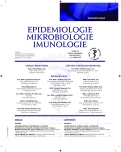Clinical and epidemiological characteristics of patients hospitalized with severe influenza in the season 2012–2013
Authors:
K. Herrmannová 1,2; M. Trojánek 2; M. Havlíčková 3; H. Jiřincová 3; A. Nagy 3; Z. Blechová 1,2; V. Marešová 1,2; J. Kynčl 3,4; O. Džupová 2,4
Authors‘ workplace:
2. lékařská fakulta, Univerzita Karlova v Praze
1; Klinika infekčních nemocí, Nemocnice Na Bulovce, Praha
2; Státní zdravotní ústav, Centrum epidemiologie a mikrobiologie, Praha
3; 3. lékařská fakulta, Univerzita Karlova v Praze
4
Published in:
Epidemiol. Mikrobiol. Imunol. 63, 2014, č. 1, s. 4-9
Category:
Review articles, original papers, case report
Overview
Aim of the study:
To characterize the clinical and epidemiological features of patients hospitalized with moderate to severe influenza infection at the infectious diseases department of a tertiary care hospital in the epidemic season 2012–2013.
Material and Methods:
A prospective observational study of patients hospitalized with influenza infection in the season 2012–2013 was carried out at the Infectious Diseases Department, Na Bulovce Hospital in Prague. Influenza infection was diagnosed by real-time quantitative polymerase chain reaction (RT-qPCR) in nasopharyngeal swab or tracheal aspirate specimens. Demographic, clinical, and laboratory data were recorded along with the disease course and outcome.
Results:
One hundred and ninety-nine patients, 85 females and 114 males (age median 47, range 1–87 years), were hospitalized with confirmed influenza in the epidemic season 2012–2013. Only seven of them got the influenza vaccine. Altogether 136 patients were diagnosed with influenza type A (91 with H1N1pdm, 33 with H3N2, and 12 with an unknown subtype), 66 patients with type B, and three patients with both types A and B. One hundred and eight patients (54%) had an underlying chronic disease, most often cardiovascular or pulmonary. The main symptoms of influenza were fever, cough, headache, myalgia, and arthralgia. Pneumonia was the most common complication: twenty-one patients suffered from primary viral pneumonia and 35 from bacterial pneumonia. Twenty-three patients (12%) needed intensive care. Six patients died and the leading cause of death was heart failure.
Conclusion:
During the epidemic influenza season 2012–2013, more patients were hospitalized than in the pandemic season 2009–2010. Also the proportions of complicated cases and case fatality ratios were fully comparable in both seasons. The fact that most patients were not vaccinated clearly supports the recommendation to vaccinate every year both the individuals at high risk of complications due to comorbidities and the healthy population.
Keywords:
chřipka – epidemie – pandemie – komplikace – pneumonie
Sources
1. WHO. Global Alert and Response. Pandemic (H1N1) 2009 - update 76 [online]. [vid. 2013-12-03]. Dostupné z:
http://www.who.int/csr/don/2009_11_27a/en/.
2. WHO. Global Alert and Response. Pandemic (H1N1) 2009 - update 90 [online]. [vid. 2013-12-03]. Dostupné z:
http://www.who.int/csr/don/2010_03_05/en/.
3. Montefiore Medical Center (2013, January 10). Significant increase in flu cases as severe flu season gains momentum. ScienceDaily [online]. [vid. 2013-12-03]. Dostupné z: http://www.sciencedaily.com/releases/2013/01/130110152602.htm.
4. Kynčl J. Analýza závažných případů chřipky v sezóně 2012 až 2013. Kongres klinické mikrobiologie, infekčních nemocí a epidemiologie. Olomouc, 17.–19. 10. 2013.
5. Džupová O, Trojánek M, Herrmanová K, Blechová Z, et al. Pandemická chřipka 2009/2010 a epidemická chřipka 2012/2013: podobnost a rozdíly. Kongres klinické mikrobiologie, infekčních nemocí a epidemiologie. Olomouc, 17.–19. 10. 2013.
6. Surveillance report: Fortnightly influenza surveillance overview [online]. [vid. 2013-12-03]. Dostupný z: http://ecdc.europa.eu/en/publications/Publications/influenza-fortnightly-surveillance-overview-24-may-2013.pdf.
7. Santa-Olalla Peralta P, Cortes-García M, Vicente-Herrero M, Castrillo-Villamandos C, et al. Risk factors for disease severity among hospitalised patients with 2009 pandemic influenza A (H1N1) in Spain, April - December 2009. Euro Surveill, 2010; 5(38):1–9.
8. Mertz D, Kim TH, Johnstone J, Lam PP, et al. Populations at risk for severe or complicated influenza illness: systematic review and meta-analysis. BMJ, 2013;347 (doi: http://dx.doi.org/10.1136/bmj.f5061).
9. Pati DR, Khanna M, Kumar B, Kumar P, et al. Clinical presentation of patients with seasonal influenza and pandemic influenza A (H1N1-2009) requiring hospitalisation. Indian J Chest Dis Allied Sci, 2013(55):15–19.
10. Rodrigo C, Méndez M. Clinical and laboratory diagnosis of influenza. Hum Vaccin Immunother, 2012;8:29–33.
11. Rothberg MB, Haessler SD, Brown RB. Complications of viral influenza. Am J Med, 2008;121:258–264.
12. Džupová O, Havlíčková M, Helcl M, Kabelková M, et al. Pacienti s pandemickou chřipkou A(H1N1)2009 v intenzivní péči. Anest intenziv Med, 2010;21:251–257.
13. Bernal E, Muñoz A, Cano A. Factor associated with prolonged hospital stay in patients with H1N1 virus influenza. Arch Bronconeumol, 2010;46:660–661.
14. Madjid M, Aboshady I., Awan I., Litovsky S, et al. Influenza and cardiovascular disease: Is there a causal relationship? Tex Heart Inst J, 2004;31:4–13.
Labels
Hygiene and epidemiology Medical virology Clinical microbiologyArticle was published in
Epidemiology, Microbiology, Immunology

2014 Issue 1
Most read in this issue
- Bacteria of the Burkholderia cepacia complex: epidemiology and diagnosis of infection in patients with cystic fibrosis
- Legionella infection – a neglected problem
- Epidemiological investigation in five dental offices of the Clinic of Dentistry, Faculty of Medicine, Palacký University, Olomouc and of the Olomouc University Hospital
- Clinical and epidemiological characteristics of patients hospitalized with severe influenza in the season 2012–2013
